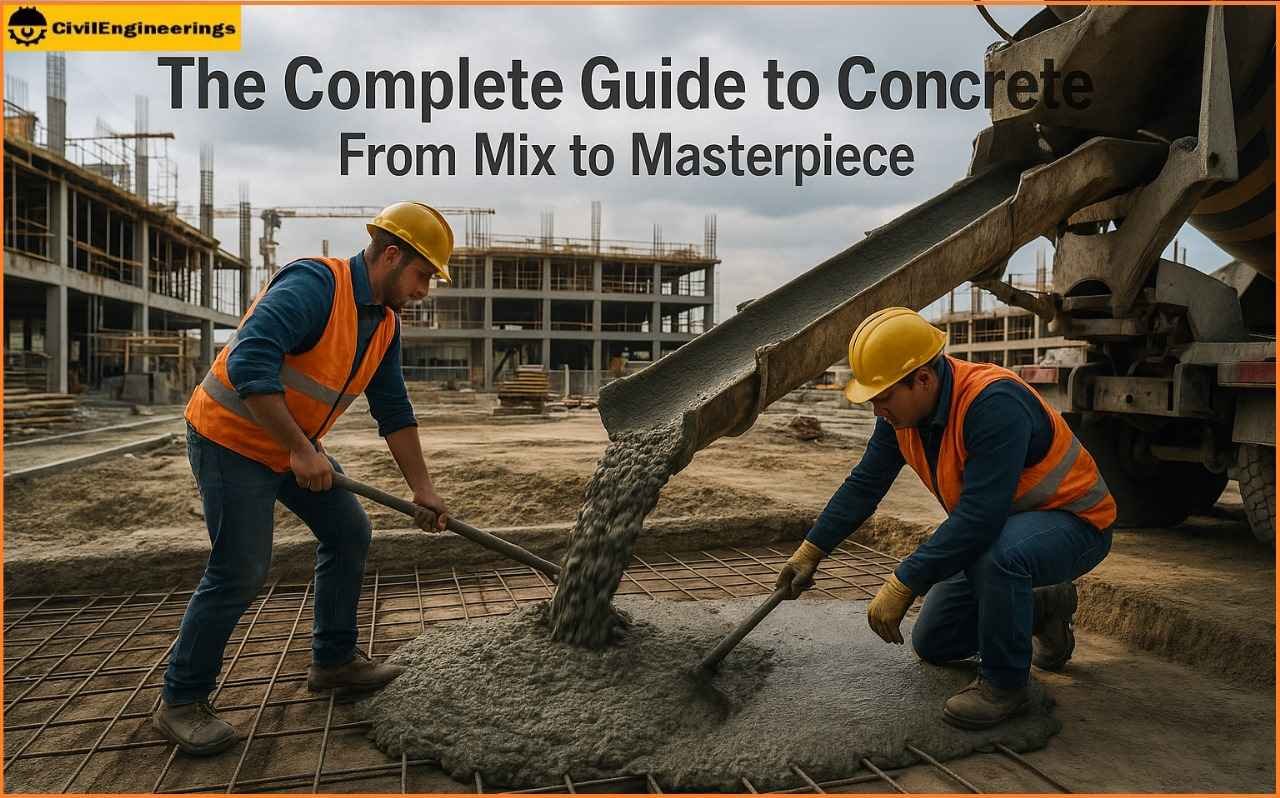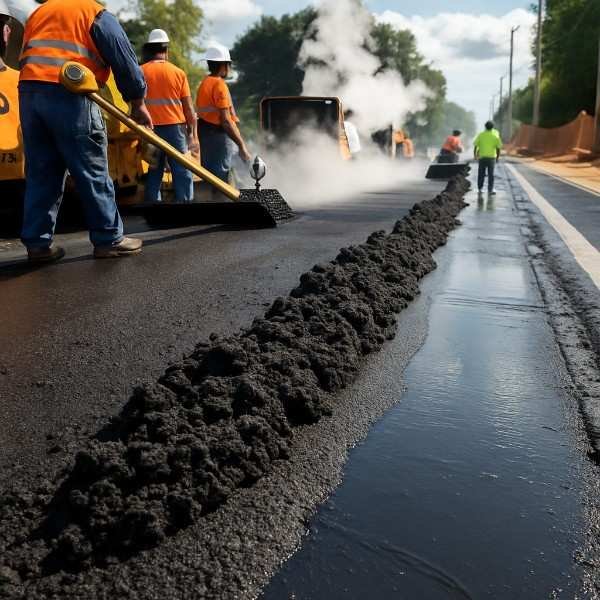Table of Contents
Introduction to Concrete
Concrete is a fundamental construction material, made by mixing of cement, coarse aggregate (crushed stone), fine aggregate (sand) and water. When cement mixes with water, it forms a paste, acts as a powerful binder, adhering the sand and crush stone together. The result is a robust and exceptionally durable material that has shaped much of our modern world. While concrete is renowned for its high compressive strength but it's crucial to remember that it is inherently weak in tension. This characteristic is why concrete structures often incorporate steel reinforcement (rebar) to handle tensile stresses, leading to reinforced concrete.
Classifications & Types of Concrete
Classification of Concrete
In order to meet the strength and durability requirements, the concrete is divided into the following categories:
a. Regular Concrete
Concrete made by using Ordinary Portland Cement (OPC) and other basic ingredients i.e. Coarse aggregate, Fine aggregate and Water, having min 28 days Cylinder Compressive strength less than 28 MPa (4000psi). For ease of use, it is further classified into the following types:
- Type A Concrete: The Concrete having min 28 days Cylinder Compressive strength 24 MPa (3500 psi). It shall be used for Structural members (RCC slabs, beams, columns, PCC works, etc.) or any other structural work where such strength is specified by the Designer.
- Type B Concrete: The Concrete having min 28 days Cylinder Compressive strength 21 MPa (3000 psi). It shall be used for Structural members (RCC slabs, beams, columns, walls, partitions) and any other structural work where such strength is specified by the Designer.
- Type C Concrete: The Concrete having min 28 days Cylinder Compressive strength 10.5 MPa (1500 psi). It shall be generally used for some structural members like foundations, hard standings, concrete blocks, etc., and any other works where such strength is specified.
- Type D Concrete: The Concrete having 28 days Cylinder Compressive strength lesser than 10.5 MPa (1500 psi). It shall be used for nonstructural works like floor underlay, lean concrete, etc., requiring low strength, or where specified as 1:4:8 and 1:6:12, etc.
b. Special Concrete
The Concrete requiring min 28 days estimated Cylinder Compressive strength, equal or more than 28 MPa (4000 psi) or requiring special features to meet higher strength, environmental, architectural and survivability requirements. Pre-stressed Concrete is the example of special concrete.
Types of Concrete
As per requirements and conditions, different types of concrete may be produced. Different types of concrete have different characteristics and qualities. Normally using concretes are as follows:
- Plain Cement Concrete or PCC: This is the basic type of concrete (also called lean concrete) which is produced by mixing normal concrete ingredients like Ordinary Portland cement, sand, aggregate, and water. This type of concrete is used under normal temperature conditions in foundations, at the bed of RCC, and drains, etc. This concrete has good compression strength but low tensile strength.
- Reinforced Cement Concrete or RCC: If steel bars are used as reinforced in concrete to increase the tensile strength of concrete, this type is called Reinforced Cement Concrete. This is the most widely used concrete in infrastructure (beams, columns, and slabs, etc.)
- Low Weight Concrete: This type of concrete has low density and weight. This concrete is made by using lightweight aggregates and more water quantity. It is used to reduce the dead load of the structure.
- Ready Mix Concrete: If concrete is made in one place through plant mixture and poured at the site using trucks, it is called ready mix concrete.
- Polymer Concrete: In Polymer concrete, polymers are used as binding material along with cement. Polymer concrete has many advantages like improved durability, reduced permeability, flexibility, and rapid setting.
- Glass Concrete: In this type of concrete, glass is used as aggregate fine, course or both. In glass concrete, wastage glass may be used. Glass concrete has many good qualities like good aesthetic appeal, unique colors and light-reflective qualities, Reduced Weight and Improved Crack Resistance.
- Pervious Concrete: Pervious concrete, also called permeable concrete, has the ability to allow water to pass through it. This penetrability makes it suitable for various applications where water controlling and drainage are vital.
- Pre-stressed Concrete: This concrete shall consist of pre-stressing by furnishing, placing and tensioning of pre-stressing steel. Pre-stressed concrete includes high-strength steel cables to impart compressive stresses to the concrete before getting external loads. Pre-stressed concrete increased structural performance, allowing greater loads and longer span. This type of concrete is commonly used in bridges, buildings, and other huge infrastructure projects.
- High-strength Concrete: High-strength concrete should have a compressive strength of 6000 psi. This concrete is made by using strong and high-quality aggregates, extra cement content and low water content. The low water quantity is managed by using superplasticizer admixture.
- Vacuum Concrete: In vacuum concrete, excessive water (which is not required for dehydration process) from concrete is extracted by using a pump with the help of Mats on filtering pads over the cement. This technique is used to get higher strength and durability level compared to normal concrete.
- Asphalt Concrete: This type of concrete is normally used to make roads, parking lots, and other flexible pavement types. Asphalt concrete, also known as bituminous concrete, is a mixture of aggregates (i.e. stone, sand, or gravel) and hot bitumen.
- Rapid Set Concrete: Rapid set concrete is made by using quick-setting admixture in the concrete repair and restoration. Rapid setting concrete is produced for applications where fast setting is required.
- Self-compacting Concrete: Self-compacting concrete is a type of concrete that is designed to flow and spread naturally without the need for vibration. Traditional concrete often requires vibration to ensure proper consolidation and removal of air voids; self-compacting concrete achieves this through its unique mix design.
- Pre-Cast Concrete: If concrete members are separately made on-site or at a concrete pre-cast factory, with proper quality control procedures and then placed in the structure, it is called pre-cast concrete.
Material Requirements of Concrete
a. Key Ingredients
Cement
Various types of Cement commonly used in Concrete works are given in Table-1. Cement shall conform to the specifications for Portland Cement ASTM C-150 / BS-12, unless otherwise specified to be of any particular quality, shall mean Ordinary Portland Cement.
| Type | Use |
|---|---|
| I | Ordinary Portland Cement: General purpose cement, when there are no extenuating conditions |
| II | Modified Cement: Aids in providing moderate resistance to Sulphate attack |
| III | Rapid Hardening Cement: When high-early strength is required |
| IV | Low Heat Cement: When low heat of hydration is desired (in massive structures) |
| V | Sulphate Resistant Cement: When high Sulphate resistance is required |
Fine Aggregate or Sand
The Fine aggregate shall be non-plastic material and shall consist of sand, stone screenings or other inert materials with similar characteristics or a combination thereof and shall not contain more than 3% of material passing Sieve # 200 by washing and not more than 1% of clay lumps or shale. Fine aggregates must be clean, inert, hard, non-porous and free from dust, laminated particles, loam, clay, organic or other impurities and silt. The Fine aggregate shall be uniformly graded and when tested as per ASTM C-117 & C-136, shall meet gradation requirements given in Table 2.
| Sieve Designation | Percentage Passing by Weight |
|---|---|
| 9.52 mm (3/8") | 100 |
| No. 4 | 95-100 |
| No. 8 | 80 - 100 |
| No. 16 | 50-85 |
| No. 30 | 25 - 60 |
| No. 50 | 5 -30 |
| No. 100 | 0 -10 |
Coarse Aggregate or Crush stone
It shall consist of crushed or broken stone, gravel or other inert material with similar characteristics or a combination. Coarse aggregates shall be hard and durable broken / crushed stone, gravel or shingle. Alternatives, like "Hard broken bricks" and "Broken CC" may be used for plain concrete only under exceptional circumstances. It shall be of uniform grading with max size as required for various types / classes of concrete meeting the grading requirements, Selection of Max Size of Aggregate is mentioned in Table 3.
| Type of Construction | Max Size of Aggregate (mm) | Max Size of Aggregate (in) |
|---|---|---|
| Plain Footings, caissons and Sub structure walls | 50 | 2 |
| Reinforced Foundation Walls and footings | 37.5 | 1-1/2 |
| Beams and Reinforced walls | 25 | 1 |
| Columns | 25 | 1 |
| Pavements and Slabs | 19 | 3/4 |
| Mass Concrete | 50 | 2 |
Water
The quality of mixing water shall be determined by ASTM-C 1602 and ASTM-C 1603. Water used in Concrete shall be clean and free from injurious amounts of acids, alkalis, salts, organic material or substances deleterious to concrete or reinforcement. Water for curing, washing aggregates & mixing shall be free from oil and shall not contain more than 1,000 ppm of Chlorides, nor more than 150 ppm of Sulphates (SO4).
Concrete Admixtures
An admixture can be defined as a chemical product which, except in special cases, is added to concrete mix in quantities not more than 5% by mass of cement during mixing or during an additional mixing operation prior to the placing of concrete, for the purpose of achieving a specific modification, to normal properties of concrete. Admixtures may be organic or inorganic in composition, but their chemical character as distinct from mineral, is their essential feature. Admixtures are commonly classified by their function in concrete. The classification as per ASTM C - 494 is mentioned in Table 4:
| Type | Description |
|---|---|
| Type A | Water-reducing |
| Type B | Retarding |
| Type C | Accelerating |
| Type D | Water-reducing and retarding |
| Type E | Water-reducing and accelerating |
| Type F | High Range, water-reducing or super plasticizing |
| Type G | High Range, water-reducing and retarding or super plasticizing and retarding |
b. Water-Cement Ratio
The max water cement ratio for Normal Concrete shall not exc 0.50 or as specified by the designer or as stated in the JMF prepared for the purpose. For Special Concrete, it shall be as specified in the design. Depending on the purpose of use, the recommended Slump for Normal Concrete is selected from Table 5.
| Type of Construction | Slump in mm (Max) | Slump in mm (Min) |
|---|---|---|
| Reinforced Foundation Walls and Footings | 75 | 25 |
| Plain Footings, Caissons and Substructure Walls | 75 | 25 |
| Beams and Reinforced Walls | 100 | 25 |
| Building Columns | 100 | 25 |
| Pavements and Slabs | 75 | 25 |
| Mass Concrete | 75 | 25 |
c. Minimum Cement Content
It shall be worked out as per the Concrete Mix Design for different strength and survivability requirements, based on ACI specifications. The Min Cement Content shall not be less than the survivability requirement, corresponding to the purpose of use. As instance a concrete mix having ration of 1:2:4 should have 1 part of cement and compare to 2 part of sand and 4 part of aggregate.
Mixing, Placing & Curing of Concrete
a. Suitable Temperature for Concrete Pouring
Temperature of Concrete under hot weather shall not exceed 32°C at the time of pouring. Following actions may keep Concrete temperature below the above limit:
- Hot Weather: Limit concrete temperature to 32°C, using cooling methods like chilled water.
- Cold Weather: Maintain concrete between 10°C and 27°C, employing heated aggregates and water as needed.
b. Placing of Concrete
Concrete shall not be poured in the forms until the Authorized Engineer has inspected the placing of the reinforcement, conduits, anchorages, and pre-stressing steel and has given his approval in writing. Following be ensured during pouring or placing of Concrete:
- Concrete, during and immediately after placing, shall be thoroughly vibrated, except lean concrete under footings and concrete deposited under water.
- Concrete in walls, beams, columns, etc., shall be placed in horizontal layers, not more than 30 cm thick.
- The Concrete shall be vibrated internally or externally or both. The vibration shall be done with care in such a manner as to avoid displacement of reinforcement, conduits, or wires.
- The compaction shall be done by mechanical vibration. The intensity of vibration shall be such as visible to affect a mass of Concrete with a 3cm slump over a radius of at least 0.5M. Concrete should not be over-vibrated to avoid segregation of materials.
- Internal vibration shall be supplemented by such an external vibrator as is necessary to ensure a smooth surface and dense Concrete.
- Construction joints shall be made only where shown or described in drawings or called for in the pouring schedule, unless otherwise approved by the Authorized Engineer.
- Maximum free fall of concrete to avoid segregation should not be more than 1.5 m.
c. Curing Methods for Concrete
Curing is essential to prevent the loss of moisture from concrete, due to sun, drying winds, and traffic, until the specified curing has been completed. Concrete shall be protected from heavy rains for 24 hours and shall be cured for 14 days. All galleries, conduits, and other formed openings through the Concrete shall be closed during the entire curing period. Concrete shall be kept wet for 15 days after laying. Following methods are used for effective curing:
Water Method
Unless otherwise approved, the concrete shall be moistened by maintaining all surfaces continuously (not periodically) wet for at least 14 days after initial setting. The temperature difference between curing water and Concrete shall not be more than 11°C (20°F). When in contact with mass concrete, steel forms shall be kept wet. Horizontal construction joints and finished horizontal surfaces shall be covered with a uniform thickness of 50mm (2 inches) of sand and kept continuously saturated to protect Concrete from frost or any other damages.
Curing Compound Method
Surfaces exposed to the air may be cured by the application of an impervious membrane if approved by the Authorized Engineer, and if the water/cement ratio of concrete is not less than 0.5. The liquid membrane-forming curing compound shall conform to ASTM C-309. The compound shall be applied with a pressure sprayer in such a manner so as to cover the entire Concrete surface with a uniform film and shall be of such character that it will harden within 30 min after application. The amount of compound applied shall be ample to seal the surface of the Concrete thoroughly. Power-operated spraying equipment shall be equipped with an operational pressure gauge and means of controlling the pressure. The curing compound shall be applied to the Concrete following the surface finishing operation, immediately after the moisture sheen begins to disappear from the surface but before any drying shrinkage or craze cracks begin to appear. Should the film of the compound be damaged from any cause before the expiry of seven (7) days after the Concrete is placed in the case of structures, the damaged portion shall be repaired immediately with additional compound. The curing compound shall be packaged in clean barrels or steel containers or shall be supplied from a suitable storage tank located at the job-site. Containers shall be well sealed with ring seals and lug-type crimp lids. The linings of the containers shall be of a character that will resist the solvent of the curing compound. Each container shall be labeled with the manufacturer's name, specification number, batch number, number of gallons, and date of manufacture. It shall have a label warning concerning flammability. Curing compound may be sampled by the Authorized Engineer at the source of supply or at the job-site.
Quality Control & Finishing of Concrete
a. Testing of Concrete
Compressive Strength of Concrete is determined from test cylinders in accordance with ASTM C-31 & ASTM C-39:
- A set of 6 cylinders (150mm dia and 300mm length) be taken from each 50 cum of Concrete mix or fraction thereof placed each day. Three of the 6 cylinders, be tested after 7 days and the remaining three after 28 days.
- The min avg 28 days test result of all samples tested at any time shall be the specified 28 days Min Cylinder Compressive strength.
- No individual sample tested after 28 days shall show a test result lower than 85% of the required 28 days.
- Concrete represented by any single test cylinder that fails to comply with the requirement as above will be rejected unless the Contractor at his expense provides evidence that the strength and quality of the Concrete placed in the work are acceptable. If such evidence consists of tests made on cores taken from the work, the cores shall be obtained and tested in accordance with ASTM C-42. Test results of the cores should meet the following requirements:
- Avg test result of the cores shall NOT be less than the min required 28 days strength.
- No. Individual core shall show strength less than 95% of the required 28 days strength.
- Other non-destructive methods of concrete tests may be allowed by the Authorized Engineer.
b. Concrete Finishing Works
- Exposed Faces: Exposed faces of cast in situ, pre-cast, and reinforced concrete shall be brought to fair and even surface by thoroughly punning (by working the Concrete against the casings and the centering) and tamping, whilst the Concrete is being poured-in and also by working over the surface with a trowel. Immediately after the removal of casings or centering, remove any irregularities and stop up air holes using CM where necessary, that will give an appearance as that of the original concrete. Unless otherwise stated, fair finish shall imply fair and smooth finish with or without rendering.
- Channels: Channels formed in Concrete shall be finished fair to proper falls with bends, stopped ends, etc., as required.
- Pointing: The joints of Concrete block walling shall be raked out as the work proceeds and the surface cleaned and brushed. Flush pointing in addition shall be executed as required.
- Linear Labours (Small): Refer to chamfers, splays, rounded angles, coved angles, bead, grooves, rebates not exceeding 100 mm girth, and moldings not exceeding 150 mm girth.
- Incidental Labours: Refer to stops, meters, rounded ends, junctions, dishing, etc., in connection with Linear or Super labour.
Joints & Form-work of Concrete
a. Concrete Construction and Expansion Joints
Construction and Expansion Joins will be provided as required in concrete work or as shown on drawing. Following be adhered during construction.
- Construction joints shall be as few as possible, and shall be made on & vertical planes only or at places shown on the drawings or approved by the Authorized Engineer. Where concreting is stopped on a vertical plane, as in beams, provide lap joint with approved stop board. Make provisions to allow the reinforcement to pass through the joints without being temporarily bent or otherwise displaced.
- In case of slabs or walls, nail a 50mm (2") x 25mm (1") fillet slightly splayed (to permit easy removal) on the joint stop board to form a joggle running throughout the length of the joint. Remove any concrete flowing pass the joint as soon as initial set occur. When concreting against a hardened surface is resumed, well roughen, wet, clean surface and apply cement sand slurry of same ratio as of mortar used in the concrete.
- Provide approved water proofer in lieu of mortar at joint, in basement and water retaining walls more than 7.5M (30 ft) long, carry out concreting such that vertical gap of about 0.7M (2ft) width with vertical joggled ends at both sides is left out at about 7.5M (30 ft). Distances are filled in after 14 days of concreting the adjacent sections.
- Form expansion joints accurately in the position and to the dimensions and details shown on the drawing and as instructed by the Authorized Engineer.
b. Form-Work
Construct formwork should strong to support the load, imposed on them, by fresh Concrete and stresses imposed by vibrating equipment and traffic. Prevent settlement of support. All joints be tight against the escape of cement and fines. Make due allowance (incl camber) for settlement and movement of forms under fresh Concrete. If metal ties are used in conjunction with bolts to pass through the Concrete, do not leave the metal closer than 50 mm (2") from the face of Concrete. Shortly before Concrete is placed, forms for exposed surfaces shall be coated with approved non-staining form oil, which shall not interfere with the setting of the Concrete nor be otherwise deleterious. After oiling, surplus oil on the form surfaces and any oil on the reinforcing steel or other surfaces requiring bond with the Concrete shall be removed. Forms for unexposed surfaces may be thoroughly wetted in lieu of oiling, immediately before placing the Concrete.
Removal of Formwork
Forms shall be removed with care so as to avoid injury to Concrete. Forms shall be removed as soon as practicable, keeping in view the min Concrete setting time requirements, to avoid delay in water curing, and to enable the earliest practicable repair of surface imperfections. In order to avoid excessive stresses in the Concrete that might result from swelling of the forms, wooden forms for wall openings shall be loosened, as soon as this can be accomplished without damage to the Concrete. Forms for the openings shall be constructed in such a manner as to be removed until the strength of the Concrete is such that form removal will not result in perceptible cracking, spalling and breaking of edges of surfaces or other damage to the Concrete. In general, the approx. elapsed time before removal of forms shall be as per Table 5.
| Position of Formwork | Min Period for Temps Over 100 C |
|---|---|
| Vertical or near vertical faces of mass concrete | 24 hours |
| Vertical or near vertical faces of reinforced walls beams and columns | 48 hours |
| Undersides of arches, beams and slabs (formwork only) | 14 days |
| Supports to underside of arches, beams and slab upto 3M (10 ft) span | 14 days |
| Supports and underside of beams, slabs larger than 3M (10 ft) span | 21 days |






